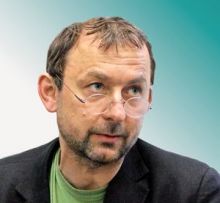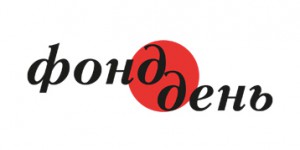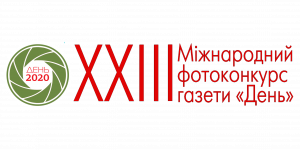The exhibit brought by Pavlo Makov to Dnipropetrovsk is named “Garden. Fragments.” According to the artist, a garden is a place between dream and reality. “Garden is not a description of rainbow hopes, but an attempt to show the world that I’m living in right now,” he says.
Makov was several minutes late for the vernissage: he was walking his labrador retriever Eva, which follows him across Ukraine. Several pictures that are on display are dedicated to the dog, particularly Rosary for Eva. “Yes, it is for her, to make her happy,” the author smiles.
“My wife and son gave me Eva as a present on my 50th birthday. She follows me on all my trips. Labrador retrievers are very clever and kind dogs. I would like all human beings to be like them.”
You are called one of the most pricey artists in Ukraine.
“Unfortunately, it was your fellow journalists who invented the term ‘most pricey.’ Moreover, it was spun out of thin air, because there are artists whose works are much more expensive than mine. The term ‘most pricey’ is caused by the current situation in general; nobody appeals against protests in modern art, these protests are simply bought. Your protest becomes an article of trade. As a result a protest turns into a hamburger. You wanted to throw it in their face, and they eat it. And you make money on this. In this sense the relation between the artist and society have changed considerably. I consider it an advantage that I live in Kharkiv, i.e., in the province, because it helps me remain myself. Publicity sometimes mixes you with things you don’t want to mingle with.”
How were you earning your life before people started to buy your works?
“In my time I used to work as a printer, later I gave lectures, and then gradually, starting from 1990, people began to buy my works. The Sumy Museum of Art was the first one to buy them. It paid me 800 rubles for three paintings in 1989. I felt like a millionaire!”
Your works are kept in many museums. Is this fact gratifying for you?
“Surely. When Tretyakov Gallery buys four of your works, at the age of 33, this is not simply gratifying, this is proof that the way you have chosen is correct. You have almost nothing, yet the Tretyakov Gallery buys your works. This helps you to overcome depression and doubts.”
What about your etching 1,000 Years of Independence. It is not consistent with the rest of the exhibit.
“I found an old album of drawings in Lviv. For the most part, these are industrial and somewhat utopian pictures. The six houses depicted in the etching are typical buildings that I regularly pass on my way home. Those are sovkhoz buildings, with eight apartments each. They look very miserable. This is a kind of symbol of the country we are living in.”
What is your favorite color?
“Black and white. I don’t think in color. There are very few artists who perceive the world in color. I know very few of them: Henri Matisse, Andrei Rublev. Even Picasso is shape and structure. It is easy to check: deprive Matisse’s works of color, and there will be nothing left, color creates the shape. This is the highest talent of visual art. Nothing will change in Picasso’s works if you take away the color. And there are no colors at all in my works.”
You were born and grew up in St. Petersburg. Do you feel that you belong to St. Petersburg?
“No. The house I was born in was destroyed by the Soviets. My grandmother was moved to a one-room apartment. I am a real nomad. I am a rolling stone, though I have stopped in Kharkiv. But in reality I am a man without place, and I am seriously concerned about this. For homeland is not St. Petersburg or Russia, it is the house in which you grew up. Nothing has been left of it. When I was 18 I tried to find that place, but new buildings are standing there, and I did not even manage to find the exact location. If I had this feeling when I was an 18-year-old boy, who was too young to feel nostalgic, what am I feeling now, at 55? Hence all my attempts to construct this place are reflected in the exhibit. I don’t belong to Petersburg, and its culture is not close to me. Even Moscow’s traditions are closer to me than those of St. Petersburg.”
Recently Kyiv has held Lilia Pustovit’s fashion show, which uses your works.
“Lilia and I met two years ago. She wanted very much to have my works in her collection. We met, and immediately found a common language, we liked each other. Now, as two years have passed, Lilia told me that she would like to use elements of my works in her collection. I transferred to her fully the author’s rights for all of my works. I sent fragments of several works of mine to her, and a collection was created on that basis.”
Whose works do you have at home?
“For the most part these are works by my fellow artists, my teacher Vitalii Kulykov, Sasha Roitburd, Oleh Tistol. We mainly exchange our works. When I have possibility, I buy their works.”
You are known abroad. Have you ever had a desire to emigrate?
“A Ukrainian artist cannot be known abroad. Figuratively speaking, Ukraine does not exist on the cultural map of the world. I have been conferred with big international awards about 20 times in my life. Several times I had to explain publicly where I come from. One day I received a loud-sounding award, Print of the Third Millennium, in France. They sent me two certificates, one of which said ‘Paul Makov, Ukraine,’ and the other ‘Paul Makov, Russia.’ In 2000 they could not decide what my nationality was, so not to offend me they sent certificates both to the Russian Paul Makov and the Ukrainian one. This was done just in case, so that I could keep the one I liked more. The fact that there is no Ukraine on the map is a question of state policy, or lack thereof. All Ukrainian state officials have a very low understanding of how Ukraine should be presented abroad. They understand that they should earn money, but they absolutely lack the understanding of what a country’s image is. Russia is present on the cultural map, unlike Ukraine.”
Why?
“Let’s take a simple example. When Putin understood that for Russia’s image Russian contemporary art should freely cross the country’s borders, go abroad and come back, he called the top customs officer and told him to open the borders. Everything was made free. I don’t support what is going on in Russian politics, but this was a clever step. In our country, when a work of art is brought out of the country, the duty is collected in full.
Is the opinion of others important for you? Would you paint living on an uninhabited island?
“When Matisse was asked this question, he replied, ‘I don’t know whether I would paint pictures, living on an uninhabited island.’ Art is a social thing. Both of us are social creatures, and be there no people around me, I might not be engaged in this. Honestly. I am doing this for others to see and have some thoughts about it.”
What about the pleasure from the process itself?
“It is present, but if it is not reinforced by feedback, sooner or later you will get bored of getting satisfaction from the sheer process, because if there is no feedback there is no inner growth either. The audience’s reaction makes you think. At first I create my works for me only, and then of course it becomes interesting for me whether other people will take interest in them.”
Do you show your emotions when you are working on the pictures?
“You know, my wife feels it. If I don’t go to the studio for a long time, it becomes increasingly hard for her to stand me. In life negative energy manages to creep in sometimes. And when I’m working it seems to go away. Then I come home calm and good.”
Does art teach you anything?
“Art is an antioxidant. It does not exclude that nothing wrong will happen to you. But like people who listen to classical music regularly, read good books, and go to museum, you face less risk of catching social cancer, i.e., becoming a bad man.”
It sounds like a religion.
“Not quite. Religion teaches you, and art gives you time to think. When the dogma that is present in any religion appears in art, it is no longer art.”







